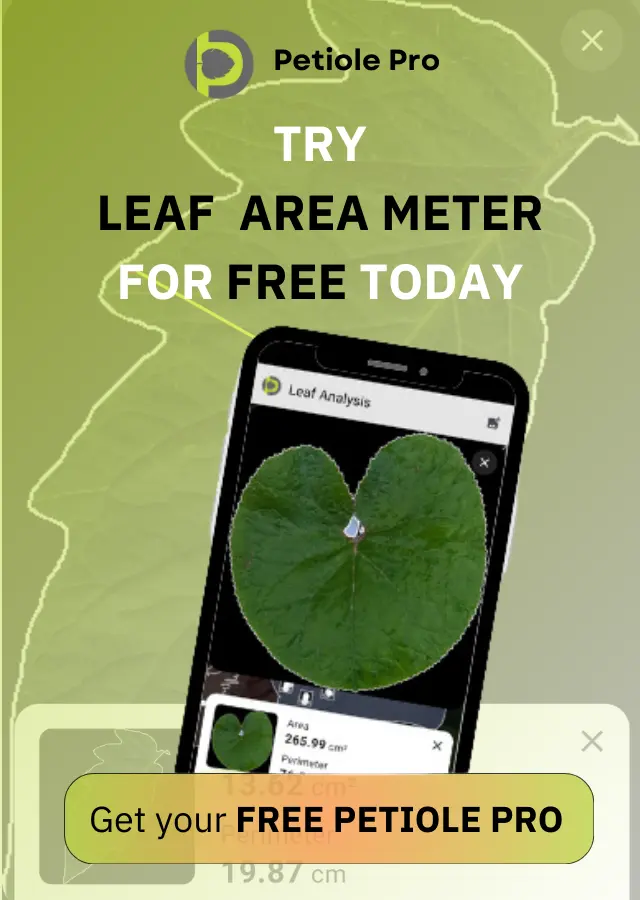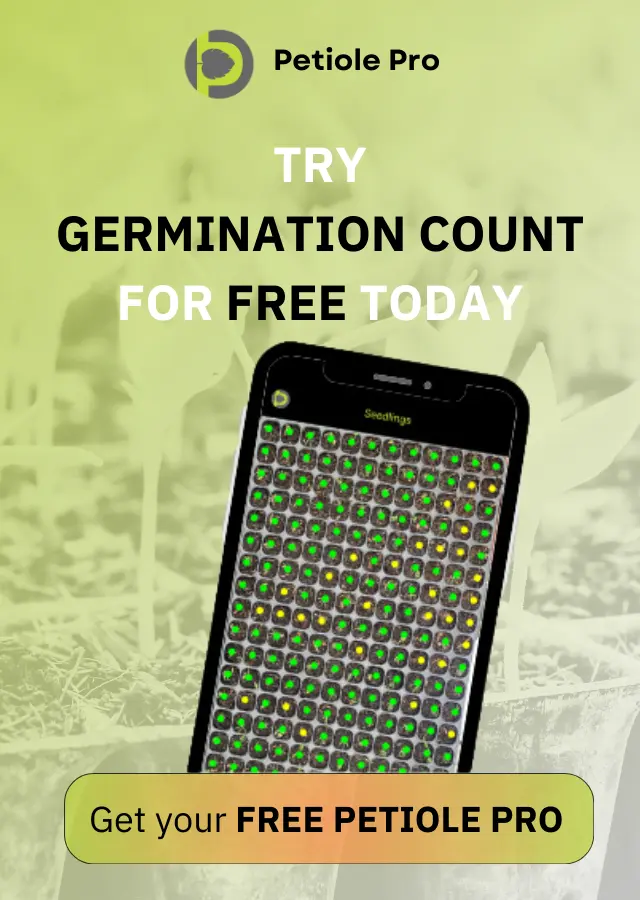Maximizing Efficiency in Leaf Measurements - Tips for Measuring Leaf Area on Field Trips


As a plant researcher or crop grower, you understand that accurate leaf measurements are vital for a successful field trip. Whether you find yourself amidst the tall stalks of corn or amidst the sprawling branches of orange trees, obtaining precise data on leaves is crucial for both phenotyping and improving yield. With tools like Petiole Pro at hand, achieving this accuracy becomes significantly simpler.
The Challenge of Measuring Multiple Leaves
Traditional leaf measurement techniques have been fraught with challenges. The use of graph papers or rulers, while common, becomes especially taxing when the volume of leaves to be measured surges. Handheld leaf area meters are too expensive and inconvenient. Consider the diversified shapes and sizes of leaves. A rice leaf’s long and slender shape is vastly different from the broader span of a grapevine leaf or the intricate trifoliates in clover. This variance makes it challenging to achieve consistency in manual measurements.
Then, there’s the daunting task of measuring overlapping or clustering leaves, common in crops like alfalfa or soybeans. These trifoliate or multifoliate structures require intricate attention to ensure no part is missed or double-counted. Furthermore, the manual method’s inherent scope for human error only exacerbates with every leaf measured. Even slight discrepancies can culminate into significant deviations when multiplied by hundreds or thousands of leaves.
The huge time investment is another problem. Manually recording the area of 200 leaves doesn’t just involve measurement, but also documentation. Transcribing these measurements into usable data sets for analysis adds another layer of potential inaccuracy.
However, the advent of digital solutions like Petiole Pro offers a respite. Leveraging technology, these platforms mitigate the challenges posed by manual methods. They provide not just speed but also unparalleled precision, regardless of the leaf’s shape or structure. The modern-day researcher, armed with such tools, is better equipped to navigate the intricate maze of leaf measurements, turning what was once an arduous task into a streamlined, efficient process.
Group Measurements for Enhanced Productivity
Efficiency is the cornerstone of any successful research project.
Mr. Tanaka, a rice researcher from Japan, found himself against the clock, needing to quickly measure a multitude of rice plant leaves during his limited field trip window. His solution? Embracing the ‘Group Measurements’ feature in Petiole Pro.
Here’s how employing the ‘Group Measurements’ technique with Petiole Pro amplifies productivity:
-
Simultaneous Data Collection: Instead of measuring one leaf at a time, placing multiple leaves (in Mr. Tanaka’s case, 4 rice leaves) together accelerates the data gathering phase.
-
Consistent Data Quality: Ensuring a small gap between the leaves for accurate segmentation guarantees that each leaf is individually recognized, thus maintaining data integrity.
-
Optimized Photo Sessions: Fewer photos are needed when measuring in groups, which translates to faster data processing and reduced storage needs.
-
Time Savings: Reducing individual leaf handling and positioning means researchers can complete their fieldwork in a much shorter time frame. In Mr. Tanaka’s situation, his work time was cut by half.
Petiole Pro’s design, optimized for such techniques, ensures that even when multiple leaves are being measured together, the precision isn’t compromised. For researchers and farmers, this means more time for analysis, strategizing, and decision-making, rather than being bogged down by the measurement process. It’s a testament to how technology, when thoughtfully designed, can transform routine tasks into efficient workflows.

Choosing the Right Data - The Power of Algorithms
In the world of digital imagery, extracting specific features from an image is pivotal. This extraction is facilitated through a process called segmentation.
Essentially, segmentation divides an image into different sections, allowing us to focus on distinct parts or features of that image.
In the context of plant phenotyping, accurate segmentation can differentiate between the leaf of interest and its background, ensuring precise measurements.
Every leaf has its own shape, color, and texture, and these characteristics can sometimes be challenging to distinguish in photographs, especially if lighting conditions aren’t optimal or if there’s a complex background. This is where Petiole Pro shines. Its advanced selection algorithms are tailored to recognize these intricacies and help researchers filter out the best measurements.
By distinguishing the leaf from its surroundings, it ensures that the data captured is purely about the leaf, minimizing errors and inaccuracies.
For plant growers and crop researchers, this means more reliable data, quicker analysis, and ultimately, better-informed decisions. Petiole Pro doesn’t just offer a digital solution; it offers an efficient, precise, and reliable partner in your research journey.
Streamlined Data Management with Algorithms
Digital image analysis in plant research is not just about capturing photos but about extracting relevant data from them. Algorithms play a pivotal role in ensuring the precision of this data extraction. When Ms. Rodríguez started her apple orchard research, she was overwhelmed by the number of photos she had to take and analyze. It wasn’t just the sheer quantity but also the quality, as some images did not represent the leaf’s true characteristics due to varying light conditions, obstructions, or even the orientation of the leaf.
Petiole Pro offers the ability to choose from multiple algorithms, each tailored to different conditions and requirements. Here’s how it made a difference for Ms. Rodríguez:
-
Tailored Analysis: Depending on the day, the lighting, and even the type of apple tree, Ms. Rodríguez could choose an algorithm that best suited her situation. This flexibility ensures that the segmentation process is adjusted optimally for every set of conditions.
-
Optimized Data Storage: With the right algorithm, only the best and most accurate representations of leaves were saved. This meant that her device and cloud storage were not cluttered with redundant or unnecessary images. Efficient data storage not only means saving space but also quicker syncs and data transfers.
-
Enhanced Data Accuracy: A precise algorithm reduces the risk of inaccuracies in measurements. For Ms. Rodríguez, this was critical. It meant that her research results were reliable, leading to actionable insights about the apple orchard’s health and productivity.
In essence, the right algorithm doesn’t just simplify the process; it refines it. For researchers and specialists like Ms. Rodríguez, this precision is invaluable, translating into more accurate data, better insights, and, ultimately, healthier crops.
Collaboration: Harnessing Collective Efforts for Expansive Terrains
Agriculture often operates on an expansive scale, where vast stretches of fields and sprawling plantations are more the norm than the exception. Within these large landscapes, an individual’s effort, while valuable, can sometimes feel like a drop in the ocean. The intricacies of such vast terrains, with diverse micro-environments, differing soil compositions, and varied plant behaviors, require a collective approach. By collaborating, researchers and growers can pool their observations, share insights, and draw more comprehensive conclusions. This collective wisdom not only accelerates data collection but also enhances its richness and depth, ensuring no nuance of the vast land goes unnoticed.
Team Up for Greater Efficiency: A Real-World Example
At a sprawling palm oil plantation in Malaysia, Mr. Azman and Mrs. Lim, two dedicated growers, showcased the immense value of collaboration. Faced with the vastness of the plantation and the diversity of palm species, solo efforts could have been both exhausting and less comprehensive. However, with each of them equipped with Petiole Pro, they could divide and conquer.
Mr. Azman focused on the western sector, analyzing the older palm trees and their matured leaves, while Mrs. Lim targeted the eastern segment where younger palm saplings dominated. Their collaborative approach not only allowed them to cover more ground in less time but also catered to the differing needs of mature and young trees.
Moreover, as they progressed, both growers diligently uploaded their measurement photos and data to a shared cloud service. This ensured real-time synchronization, allowing each of them to view the other’s progress and findings. Such seamless data integration eliminated any potential overlaps or omissions, ensuring that every leaf across the vast plantation was accounted for. Through this synergized approach, they reaffirmed the old adage: teamwork indeed makes the dream work.
In conclusion, integrating technology with traditional fieldwork not only makes tasks manageable but also ensures the precision of results. By understanding and utilizing tools like Petiole Pro, researchers and growers can ensure a future where understanding plants becomes simpler and more effective.
Get more information about maximizing efficiency in leaf measurements on field trips in our recent video:


